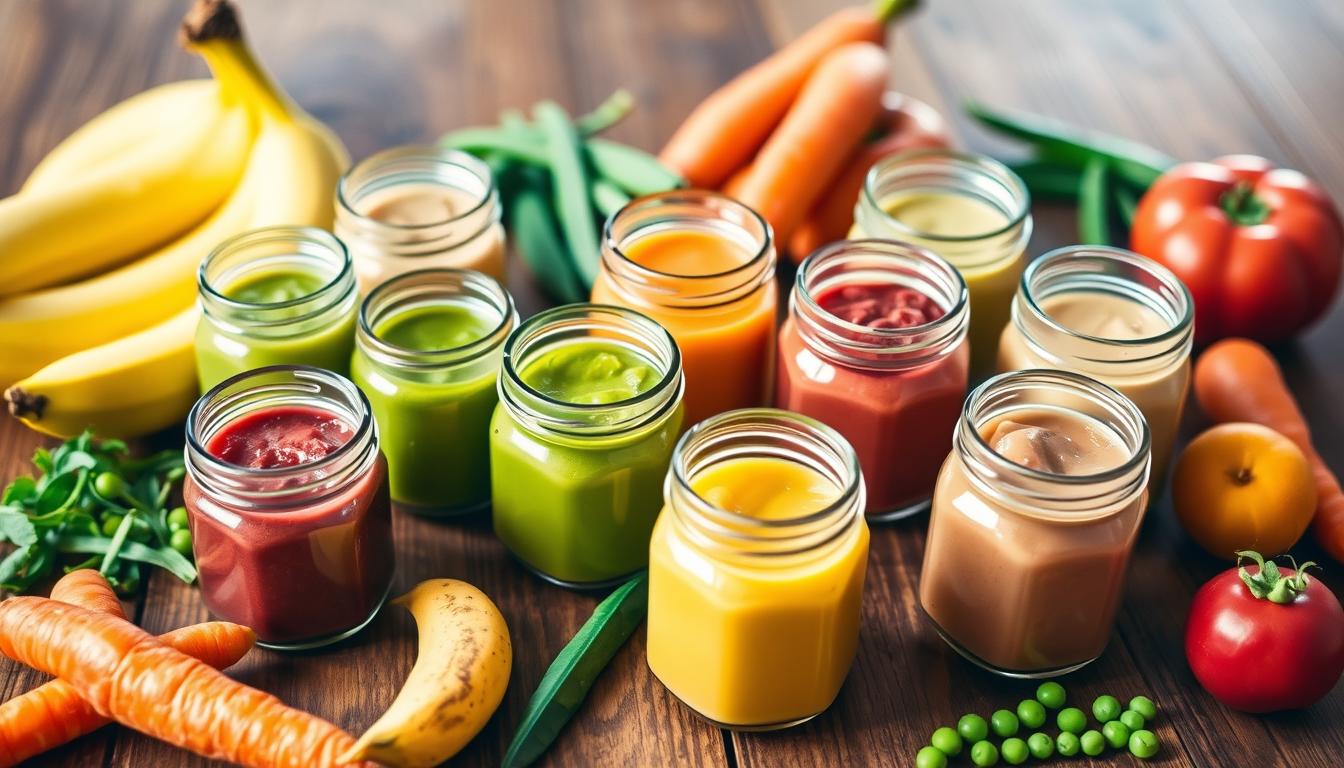Starting your baby on solid foods is both thrilling and daunting. There are so many choices, it’s easy to feel lost. But, I’m here to help you through the world of Stage 2 baby food. It’s a great step for your growing baby.
When my son was ready for Stage 2, I felt both excited and nervous. Would he like the new textures? Would I give him the nutrients he needs? These thoughts were on my mind a lot. But, learning about Stage 2 baby food helped me feel better and helped my son start eating well.
In the following sections, I’ll share what I’ve discovered. I want to help you choose the best Stage 2 baby food for your baby. We’ll talk about what nutrients are important, the right textures, and the good and bad of homemade versus store-bought foods. With this info, you’ll feel ready to guide your baby through this new food adventure.
Table of Contents
Understanding Stage 2 Baby Food
As your baby grows, their nutritional needs evolve. Around 6 to 8 months, it’s time to transition from stage 1 to stage 2 baby food. They offer more calories, protein, and important vitamins and minerals for their fast growth.
Key Nutritional Requirements for Growing Infants
Babies need more nutrients to grow their bodies and brains. Stage 2 baby foods have more iron, zinc, and calcium. These are key for healthy growth and development.
When to Transition from Stage 1 to Stage 2
The right time to switch to stage 2 baby food is when your infant can sit up and likes more textured foods. This is usually around 6-8 months. Watch for signs like being able to grasp small food pieces and wanting to chew and swallow.
Texture and Consistency Guidelines
Stage 2 baby foods are thicker and have small, soft chunks. This helps with chewing and developing oral motor skills. The texture also prepares your baby for eating table foods and self-feeding.
“Introducing new textures and flavors at this stage is essential for your baby’s development and establishing healthy eating habits.”
Best Fruits and Vegetables for Stage 2 Baby Food
When your baby moves to Stage 2, it’s time to add more fruits and veggies to their diet. These foods are thicker and chunkier, helping your baby learn to chew and swallow. This stage is all about practicing these important skills.
For Stage 2, think about using bananas, avocados, apples, pears, and mangoes. These fruits are sweet, creamy, and full of vitamins and fiber. You can mash or puree them to a thicker texture. Or, offer them in small, soft pieces for your baby to explore.
For veggies, sweet potatoes, carrots, peas, and spinach are great choices. Cook them until soft, then mash or blend into a thicker puree. Mixing fruits and veggies can make tasty and healthy meals for your baby.
“Variety plays a crucial role in Stage 2 baby food. A wide range of fruits and veggies gives your baby essential nutrients. It also helps them develop a love for different tastes and textures.”
Always introduce new foods one at a time, waiting three days before trying another. This helps spot any allergies. With a bit of creativity and lots of love, you can make Stage 2 baby food that’s both fun and nutritious.
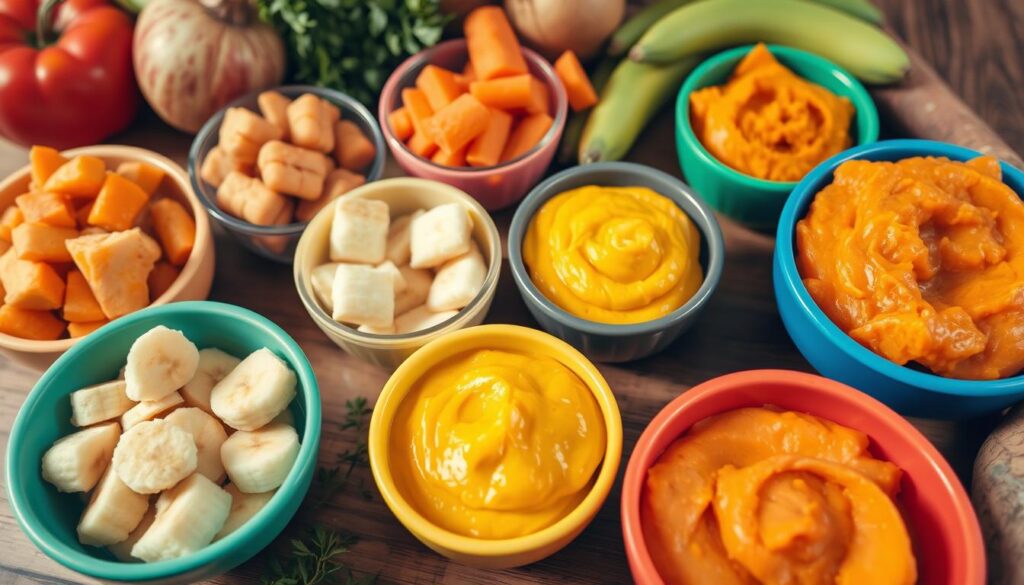
Essential Nutrients in Stage 2 Baby Food
When your baby moves to stage 2 baby food, it’s key to make sure they get all the nutrients they need. These foods should have a mix of vitamins, minerals, and other important elements. This helps your baby grow fast and develop well.
Vitamins and Minerals for Development
Stage 2 baby foods need to have important vitamins and minerals. These include:
- Vitamin A supports healthy vision and strengthens the immune system.
- Vitamin C to support the immune system and collagen production
- Vitamin D for strong bones and teeth
- Vitamin E as an antioxidant to protect cells from damage
- Iron helps prevent anemia and supports your baby’s cognitive development.
- Calcium and zinc for optimal growth and development
Protein Sources for Growing Babies
Protein is vital for your baby’s muscle growth and repair. Stage 2 baby foods can get protein from:
- Pureed meats, such as chicken, turkey, or beef
- Legumes like pureed lentils or beans
- Dairy products like yogurt or cottage cheese
Healthy Fats for Brain Growth
Fats, mainly the healthy unsaturated kind, are key for your baby’s brain growth. Look for stage 2 baby foods with:
- Avocado
- Olive oil
- Fatty fish like salmon or tuna
By choosing a variety of nutrient-rich foods, you can help your baby get the essential nutrients they need. This is important for their growth and development at this stage.
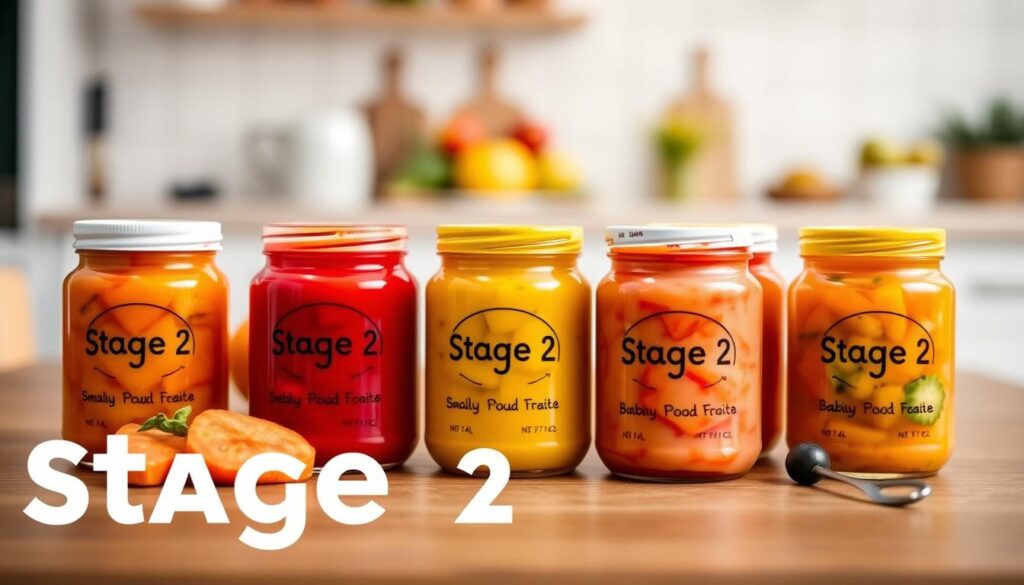
Homemade vs. Commercial Stage 2 Baby Food
Choosing between homemade and commercial stage 2 baby food is a big decision. Both have their own benefits, depending on your family’s needs and your baby’s tastes.
Homemade baby food lets you pick the ingredients. This means your baby gets the freshest, healthiest food. It’s also cheaper and better for the planet, as you use seasonal foods and less packaging. You can make tasty stage 2 recipes, like stage 2 baby food recipes with different fruits and veggies.
Commercial options, like Gerber baby food stage 2, are easy and consistent. They’re made to give your baby all the nutrients they need. They’re a reliable source of important vitamins and minerals.
| Homemade Stage 2 Baby Food | Commercial Stage 2 Baby Food |
|---|---|
| Greater control over ingredients | Consistent nutrient profile |
| More cost-effective | Convenient and ready-to-serve |
| Environmentally friendly | Carefully formulated for infant needs |
| Customizable recipes | Variety of flavors and textures |
Think about your time, budget, and your baby’s likes when choosing. Both homemade and commercial foods can help your baby grow strong and healthy.
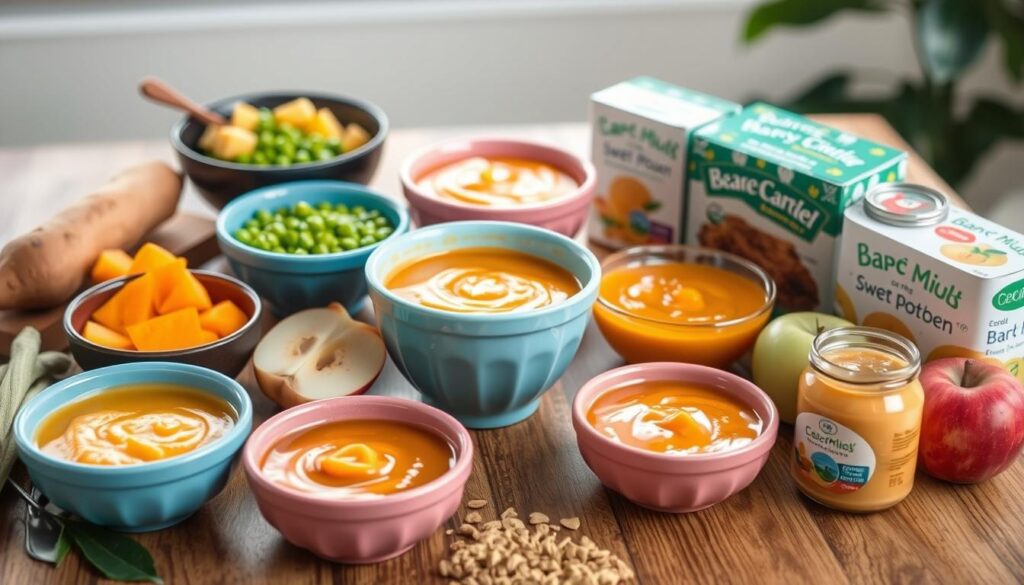
Safe Preparation and Storage Methods
When making stage 2 baby food, keeping food safe is key. First, wash your hands and all tools well. This keeps your workspace clean and stops harmful bacteria from getting to your baby.
Kitchen Safety Guidelines
Before you start, make sure your kitchen is clean. Rinse fruits and veggies under cool water to get rid of dirt. Also, make sure all your tools, like blenders and containers, are clean and free of germs.
Proper Storage Techniques
Homemade stage 2 baby foods can stay in the fridge for 48 hours or in the freezer for 3 months. Store them in airtight containers. After opening commercial baby food, keep it in the fridge and use it in 1-2 days.
Signs of Spoilage
Always check the food before feeding your baby. Look for bad smells, color changes, or mold. If you see any, throw it away and make something new.
By following these steps, you can make sure your baby’s stage 2 baby food is healthy and safe. This way, you give your baby the best food possible.
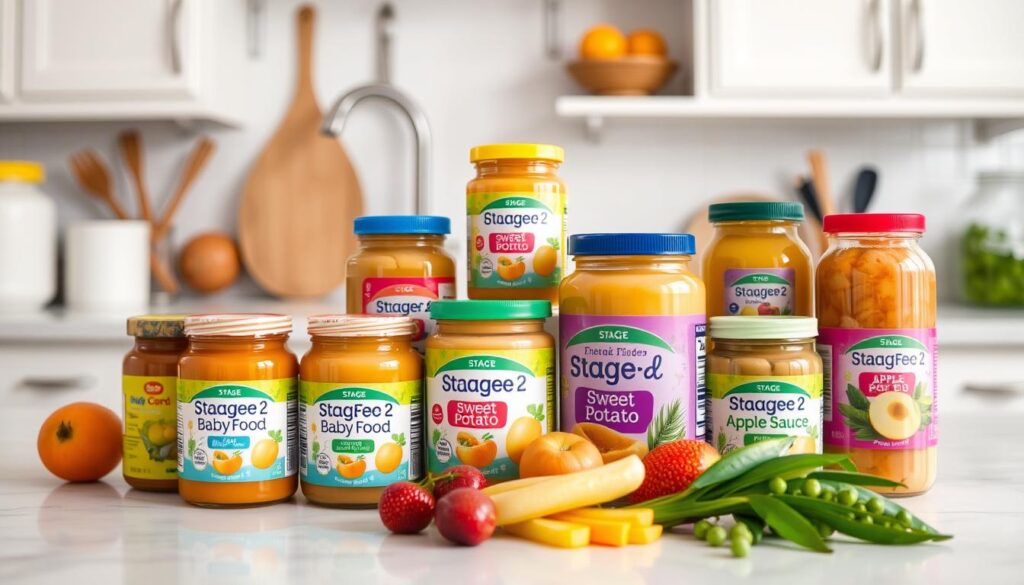
“Ensuring your baby’s food is safe and high-quality is essential. Take the time to follow proper preparation and storage methods to provide your little one with the best possible nourishment.”
Creative Stage 2 Baby Food Combinations
As your little one moves to Stage 2 baby foods, a world of flavors opens up. Try mixing fruits and veggies to make tasty stage 2 baby food recipes. Sweet potato and apple make a great pair, or banana and avocado are a nutrient-rich choice.
Adding whole grains like oatmeal or quinoa to fruit purees boosts nutrition. These ingredients give energy and introduce new textures to your baby’s taste buds.
Need ideas? Stage 2 Gerber baby food has many tasty mixes. Use these as a starting point to make your own dishes, tailored to your child’s tastes and needs.
“Continually introducing children to fruits and veggies in a neutral way can encourage them to try new foods.”
Introduce new tastes and textures slowly and carefully. Always check with your pediatrician to make sure the transition is smooth and safe for your baby.
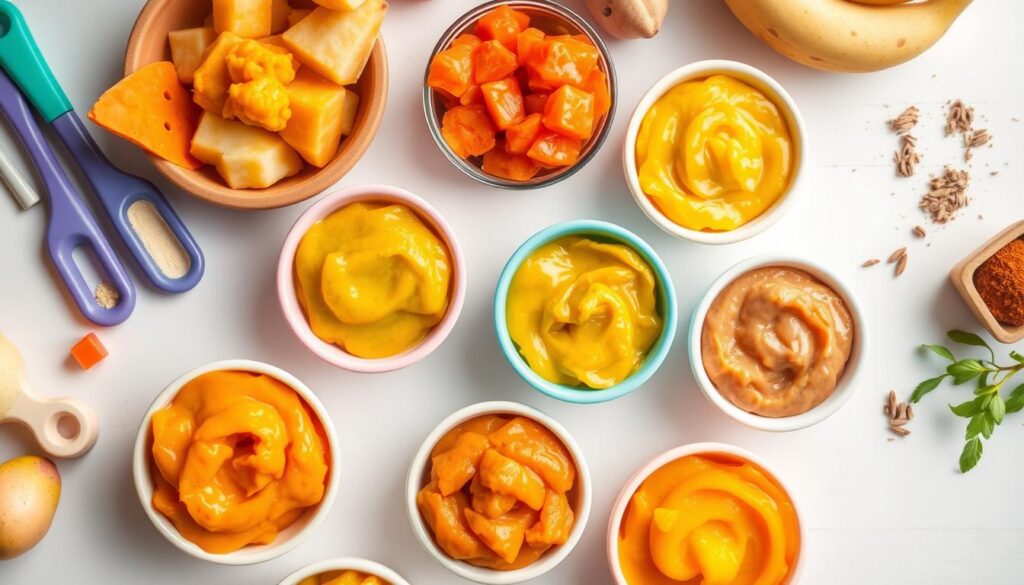
Start a flavor adventure with your growing baby. The world of stage 2 baby food recipes is full of possibilities. Get ready to surprise your little one with new flavors, one spoonful at a time.
Common Allergies and Food Sensitivities
Exploring stage 2 baby foods means knowing about allergies and sensitivities. About 1 in 13 kids have a food allergy, says the CDC. Be careful with common allergens like eggs, dairy, peanuts, tree nuts, soy, wheat, and fish.
Identifying Allergic Reactions
Look out for signs like rashes, vomiting, or trouble breathing with new foods. Introduce one new food at a time.. Wait 3-5 days before trying another. This helps find out what causes an allergic reaction.
Foods to Introduce with Caution
- Dairy, like cow’s milk protein, often causes allergies in infants. Over 50% of babies allergic before age one have a cow’s milk protein allergy.
- Up to 3% of babies get a food allergy before their first birthday.
- Peanuts, tree nuts, and soy are also high-risk foods to introduce carefully.
Working with Your Pediatrician
Consult your pediatrician if you have concerns about allergies or sensitivities. They can guide you on introducing risky foods and watch for reactions. Being careful and working with your doctor ensures your baby’s safety and health with stage 2 foods.
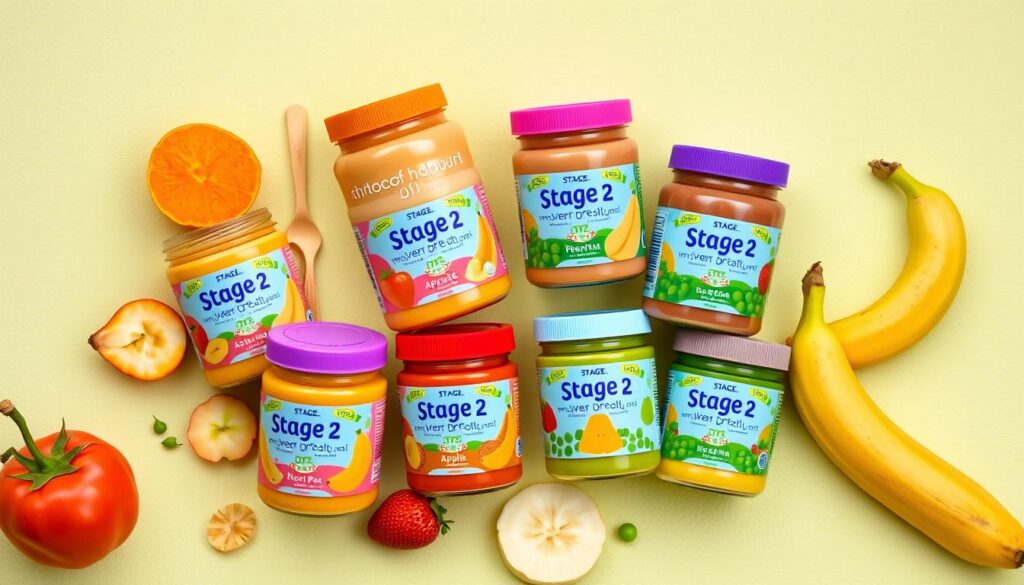
| Common Food Allergens | Prevalence in Infants |
|---|---|
| Dairy (cow’s milk protein) | Over 50% of babies with food allergies before age one |
| Peanuts, Tree Nuts, Soy | Up to 3% of babies develop at least one food allergy before age one |
| Eggs, Wheat, Fish | Significant risk of food allergy in infants |
Be alert for signs of allergic reactions when introducing new stage 2 foods. Always work with your pediatrician for a safe and healthy journey for your baby.
Establishing Healthy Feeding Routines
When your baby starts stage 2 baby food, it’s key to have a regular feeding schedule. This helps them grow well. Babies usually start solids around six months, when they’ve doubled their birth weight. Give them 3-4 meals a day, along with their usual milk or formula.
Help your baby learn to feed themselves with soft foods. This allows them to explore new tastes and textures at their own pace. Make mealtime calm and free from distractions. Be patient as they get used to eating solids. The first teeth often come in around six months, so pick the right texture for baby food stage 2.
- Start with single-ingredient purees like sweet potato, carrot, butternut squash, banana, avocado, and apple.
- Gradually add foods that might cause allergies, like peanut butter, eggs, dairy, fish, and soy. Wait 3 to 5 days before introducing another new food.
- Make sure your baby’s diet is balanced with iron, zinc, vitamin D, and healthy fats.
By sticking to a regular feeding routine and letting your baby explore, they’ll learn to love food. Don’t forget to book their first dental visit by their first birthday. Also, give them small amounts of water throughout the day, after solid meals.
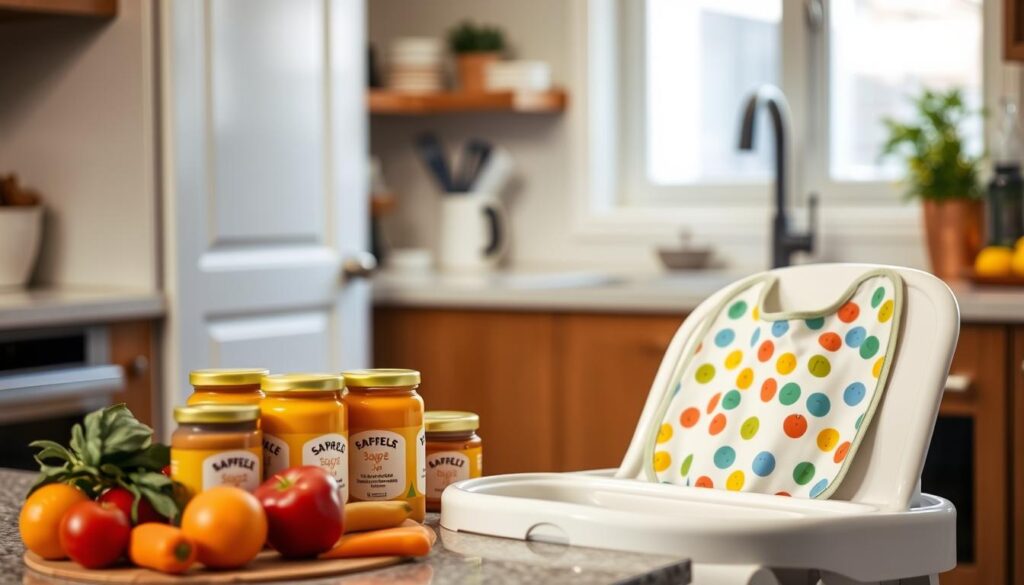
Conclusion
When exploring stage 2 baby food, remember to offer a variety of nutrient-rich foods. This is important for your baby’s growth and development. You can either make your own purees or choose commercial brands. Always consult your pediatrician for guidance on what’s best for your baby.
Knowing about essential nutrients, textures, and allergies is key. This way, you can make sure your baby gets the right food at the right time. Introduce new tastes and textures, but watch how your baby reacts.
Remember, stage 2 baby food is not the same for everyone. Adjust your approach to fit your baby’s needs. Stay updated on food safety laws too. With the right knowledge and care, you can help your baby grow healthy and strong.
FAQ
What is the purpose of Stage 2 baby food?
What are the key nutritional requirements for Stage 2 baby food?
When should I transition my baby from Stage 1 to Stage 2 baby food?
What is the texture and consistency of Stage 2 baby food?
What are the best fruits and vegetables for Stage 2 baby food?
What are the differences between homemade and commercial Stage 2 baby food?
How should I safely prepare and store Stage 2 baby food?
How can I introduce Stage 2 baby food safely?
How do I establish a healthy feeding routine for Stage 2 baby food?
Source Links
- Puree for Babies
- Organic Baby Food Shop Blog
- First Year Feeding Schedule: How Much Should a Newborn Eat? | Pampers
- What to know about baby-led weaning
- Debunking Baby Food Myths: Facts vs. Fiction | Little Spoon – Is This Normal
- Top 10 Healthy Baby Weaning Foods And How To Start Them
- 6 Months Old Baby Food Chart
- How to Read a Baby Food Label
- Baby & Me 2™ Prenatal Multi
- Holle Goat Milk Formula Stage 2 6-12 months | 400g box
- A Beginners Guide for Baby Led Weaning
- Healthy Homemade Pureed Meals for Kids: A Detailed Guide – Richmond Mom
- The Ultimate Guide to Making Stage 1 Baby Food at Home
- Your Questions Answered
- Beyond the Bottle: Creative Recipes Using Baby Formula for Growing Little Gourmets
- Home – Tummies Full Of Love
- How to Sneak Vegetables (and Fruit) into Kids’ Food
- Allergies in infants: Understanding food allergies and seasonal allergies
- Perfect Parenting is a Myth
- 6 month milestone feeding guide
- Transitioning Babies To Solid Foods – Heritage Dental Centre
- HappyBaby Baby Food Lawsuit
- Baby Food Autism Lawsuits: Updates and Settlements (December 2024)
- News & Publications — First Steps Nutrition Trust
